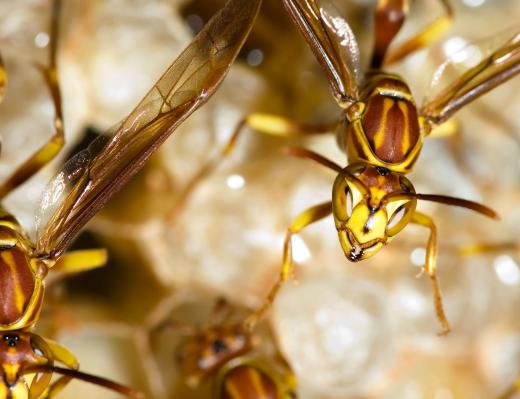What Is the Haploid?
Haploid cells are cells that consist of only one pair of chromosomes, which are structures in the cell nucleus containing genetic information that is responsible for the transmission of hereditary traits to offspring. While most adult cells in eukaryote organisms are diploid, possessing two sets of chromosomes each, adult males in the hymenoptera insect order of ants, wasps, and bees are composed of haploid cells. Sperm and egg cells in most organisms are also haploid in nature until they unite in the fertilization process and become diploid.
Chromosomal information is used to perpetuate a species, and this information is joined when male and female sex cells are united so that the shared genetic information from both parents can benefit the offspring by offering it many potentially dominant traits. Some offspring, however, do not require this level of genetic information to fulfill their function. Male wasps, ants, and bees only contain haploid cells because they grow from unfertilized eggs into adults. In certain species of fungus and algae as well, haploid cell structures are the norm.

Plants have the ability to switch between a haploid state and one of diploidism or a double haploid state, which is now an important feature of plant breeding to control the genetic traits of such crops as barley, tobacco, and rapeseed. Over 250 species of plants have now been genetically modified to be double haploids, using methods of asexual reproduction, or parthenogenesis, to produce offspring without fertilization and eliminate unwanted chromosomes. One of the additional benefits of double haploid plants is that their offspring are genetically identical to the parent plants, which eliminates variations in crops down the line when traditional diploid reproduction takes place.
One of the disadvantages of haploid organisms, whether natural or genetically modified, is that, if a gene turns out to be defective, there is no identical copy of it to perform its function in its place as exists with diploid cells. Every gene in a haploid organism is effectively expressed, either performing its function properly or negatively effecting the health and viability of the organism. In examining haploid yeast cultures, evidence also suggests, however, that the mutation rate in organisms is effectively double in diploid cells, since haploid cells have only half as many genes that can mutate.
Evolutionary biology has been researching the cause behind the dominance of diploid cells and sexual over asexual reproduction for some time. Research indicates that haploid-based organisms are more rare not because they are more vulnerable to environmental stresses, but because haploid organisms over succeeding generations lose their capability to reproduce. Sexual fitness, therefore, is most likely the primary reason that haploids are rare in nature, even though they are less susceptible to the harmful mutations that diploids can undergo.
AS FEATURED ON:
AS FEATURED ON:











Discussion Comments
@Ceptorbi, there are 23 haploid chromosomes in humans. When the 23 haploid chromosomes in the egg unite with the 23 haploid chromosomes in the sperm during fertilization, a diploid of 23 pairs of chromosomes results.
What's the haploid number of chromosomes in humans?
Post your comments